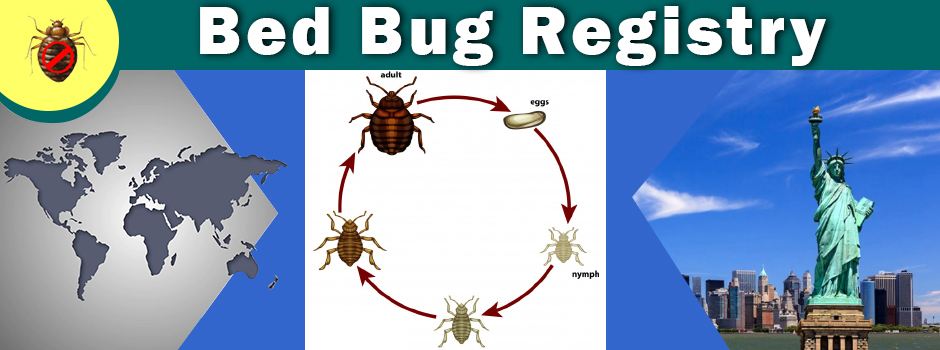Humans and bed bugs have a long association. Records of bed bug infestations date back at least to 400 B.C. Before World War II, bed bugs were very common in homes, hotels, and boardinghouses. It was not until modern insecticides were developed that bed bugs could be easily eliminated. Today, bed bugs are uncommon pests. Many infestations identified as bed bugs are actually closely related species such as bat bugs or swallow bugs. Knowing what species has infested a house is an important distinction when planning a control strategy. While all of these bugs are external, bloodsucking parasites of warm-blooded animals, each type has a preferred host. Knowing the preferred host is essential to locating and eliminating the source of the bugs.
All members of this group share similar characteristics. They are about 3/16" long, broadly oval and flat. Most are mahogany or red-brown in color. The larvae are very small and clear. After feeding bed bug larvae can resemble small drops of fresh blood. Bed bugs have straw-like (piercing-sucking) mouthparts. Their wings are very short and look like small pads. They can not fly. Bed bugs are known to give off what has been described as an obnoxiously sweet odor, or an odor similar to fresh raspberries. They will leave small spots of dried blood on the sheets and walls after feeding. If you discover a bug, have a professional identify it.
The bite of a bed bug is not painful and usually the host initially is unaware of the bite. Many people have an allergic reaction to the saliva injected into the skin by the bug. Often there is a large oval or oblong, inflamed swelling, called a wheal, at the feeding site. It may be accompanied by intense itching. Rarely when a person is hypersensitive, asthmatic symptoms may occur.
Bed bugs have been implicated for the transmission of at least 41 human diseases, vitamin and mineral deficiencies, and allergic reactions, but they have not been proven responsible for any epidemics or serious disease outbreaks. Thus, they are considered nuisance pests, and are not an important medical problem.
After a blood meal, female bed bugs will lay one to five eggs a day. With multiple feedings they may lay 200 or more eggs during their life. Eggs are usually laid on a rough surface in a protected place like in a crack or crevice in walls or floors. In heavy infestations bed bugs will lay eggs on garments. The young bugs, or nymphs, molt five times before becoming an adult and must have a blood meal before each molt. If conditions are good, nymphs can become adults in six to seven weeks. In cases of starvation bed bugs can live more than 260 days. However, in all stages, bed bugs can go for long periods without a blood meal, so their life cycle may be many months long. Adult females can survive more than 150 days without food.
Bed bugs are nocturnal insects. They hide in protected places during the daytime and emerge at night to feed on their sleeping hosts. Some of their more common hiding places are behind molding, in mattress seams, bedframes, loose wallpaper, and cracks in hardwood floors. With a large infestation, they may be found farther away from a potential host. If the problem is not bed bugs, but rather one of the other closely related bat bugs or swallow bugs, the harborages might be in an infested attic or chimney where the preferred host may be found.
Because bugs hide, having an infestation without actually seeing any of them is possible. If you suspect you have bed bugs, look for small spots of blood on bedding or walls. There may be black or brown spots left behind around well-used hiding or resting places. These spots are dried-excrement.
As with most pest problems, the beginning point for making control decisions should be based on identification and inspection. With bed bugs and their cousins, a species identification is important because it will help determine the focal point for the infestation. Because true bed bugs are uncommon, often the source of the problem is roosting bats and nesting birds. In these two cases, ridding a structure of the source is essential for control. Before any treatments are applied to control the bugs, the bats or birds should be removed from the structure. This often requires the skill of a professional pest control operator because of the complex behavior of the offending animal. Be aware that killing migratory birds and some bats is illegal, because they are federally protected.
Deep cleaning should follow. All areas where infestations are found should be thoroughly vacuumed. Vacuum mattresses, bedframes, and stuffed furniture in infested rooms. Flooring and carpeting also should be well-vacuumed. Pay close attention to edges and loose areas where bugs could hide. After finishing vacuuming, put the vacuum cleaner collection bag into a plastic bag, seal it and place it in an outdoor trash receptacle immediately. Cleaning egg infested garments is also important.
Once the source has been removed, the next step should be a crack and crevice treatment with an insecticide labeled for the target site. In rooms where infants, children or elderly people will spend many hours such as a bedroom, take care to only treat potential harborage areas. Bed bugs and other closely related bugs may be difficult to control because of their many hiding places. You may need to hire a professional pest control specialist to resolve this problem.
Go here to see the original:
Bed Bugs - Clemson University, South Carolina

 Residence
Residence  Location
Location 










